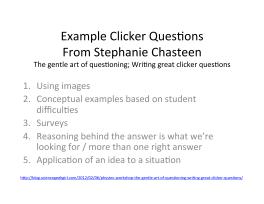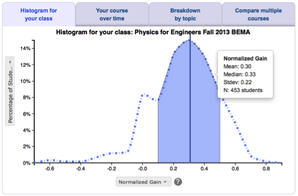
Developed by: N/A






middle schoolhigh schoolintro collegeinter-mediateupper levelgrad school other

calc based

alg based

conceptual










Overview
What? Students use electronic devices to answer questions and instructors collect and display responses, facilitating student engagement and collaboration. Can be used as a part of many different teaching methods, including Peer Instruction, TEFA, and CAE Think-Pair-Share.
Why? Clickers are an easy way to add interactivity to a traditional lecture course without making drastic changes. They are a useful tool to get your students engaged and talking, and to help you learn and respond to what your students are thinking, both of which can lead to improved student learning.
Why not? If you just use clickers to give quizzes or take attendance, students will resent them and won't learn more. Clickers add an extra cost for students, which may not be worth it. Flashcards are cheaper, and may be better because students are more accountable when you can see their answers.
Classroom video
Student skills developed
- Conceptual understanding
- Problem-solving skills
- Making real-world connections
- Using multiple representations
- Metacognition
Instructor effort required
- Medium
Resources required
- Clickers / polling method
- Cost for students
Resources
Teaching Materials
See our Expert Recommendation on finding good questions to use with clickers or Peer Instruction for an extensive list of databases of clicker questions, as well as suggestions for writing your own questions.
Research
This is the third highest level of research validation, corresponding to:
- at least 1 of the "based on" categories
- at least 1 of the "demonstrated to improve" categories
- at least 1 of the "studied using" categories
Research Validation Summary
Based on Research Into:
- theories of how students learn
- student ideas about specific topics
Demonstrated to Improve:
- conceptual understanding
- problem-solving skills
- lab skills
- beliefs and attitudes
- attendance
- retention of students
- success of underrepresented groups
- performance in subsequent classes
Studied using:
- cycle of research and redevelopment
- student interviews
- classroom observations
- analysis of written work
- research at multiple institutions
- research by multiple groups
- peer-reviewed publication
References
- I. Beatty, W. Gerace, W. Leonard, and R. Dufresne, Designing effective questions for classroom response system teaching, Am. J. Phys. 74 (1), 31 (2006).
- C. Herreid, 'Clicker Cases': Introducing Case Study Teaching into Large Classrooms, J. Coll. Sci. Teaching 36 (2), 43 (2006).
- P. Hu, Y. Li, and C. Singh, Using a clicker question sequence to teach time-development in quantum mechanics, presented at the Physics Education Research Conference 2021, Virtual Conference, 2021.
- P. Hu, Y. Li, and C. Singh, Development, validation and online and in-person implementation of clicker question sequence on quantum measurement uncertainty, presented at the Physics Education Research Conference 2022, Grand Rapids, MI, 2022.
- P. Justice, E. Marshman, and C. Singh, Development and validation of a sequence of clicker questions for helping students learn addition of angular momentum in quantum mechanics, presented at the Physics Education Research Conference 2018, Washington, DC, 2018.
- P. Justice, E. Marshman, and C. Singh, Development, validation and in-class evaluation of a sequence of clicker questions on Larmor precession of spin in quantum mechanics, presented at the Physics Education Research Conference 2019, Provo, UT, 2019.
- C. Keller, N. Finkelstein, K. Perkins, S. Pollock, C. Turpen, and M. Dubson, Research-based Practices For Effective Clicker Use, presented at the Physics Education Research Conference 2007, Greensboro, NC, 2007.
- V. Kuo, P. Kohl, and L. Carr, Socratic Dialogs and Clicker use in an Upper-Division Mechanics Course, presented at the Physics Education Research Conference 2011, Omaha, Nebraska, 2011.
- N. Lasry, Clickers or Flashcards: Is There Really a Difference?, Am. J. Phys. 46 (4), 242 (2008).
- A. Lee, Development and Evaluation of Clicker Methodology for Introductory Physics Courses, PhD, Ohio State University, 2009.
- K. Perez, E. Strauss, N. Downey, A. Galbraith, R. Jeanne, and S. Cooper, Does Displaying the Class Results Affect Student Discussion during Peer Instruction?, CBE Life. Sci. Educ. 9 (2), 133 (2010).
- K. Perkins and C. Turpen, Student Perspectives on Using Clickers in Upper-division Physics Courses, presented at the Physics Education Research Conference 2009, Ann Arbor, Michigan, 2009.
- S. Pollock, S. Chasteen, M. Dubson, and K. Perkins, The use of concept tests and peer instruction in upper-division physics, presented at the Physics Education Research Conference 2010, Portland, Oregon, 2010.
- E. Price, C. De Leone, and N. Lasry, Comparing Educational Tools Using Activity Theory: Clickers and Flashcards, presented at the Physics Education Research Conference 2010, Portland, Oregon, 2010.
- R. Sayer, E. Marshman, and C. Singh, The impact of peer interaction on the responses to clicker questions in an upper-level quantum mechanics course, presented at the Physics Education Research Conference 2016, Sacramento, CA, 2016.
- P. Shekhar and M. Borrego, ‘Not hard to sway’: a case study of student engagement in two large engineering classes, Eur. J. Engr. Educ. 43 (4), 585 (2016).
- E. Watkins and M. Sabella, Examining the Effectiveness of Clickers on Promoting Learning by Tracking the Evolution of Student Responses, presented at the Physics Education Research Conference 2008, Edmonton, Canada, 2008.
- S. Willoughby and E. Gustafson, Technology talks: Clickers and grading incentive in the large lecture hall, Am. J. Phys. 77 (2), 180 (2009).









